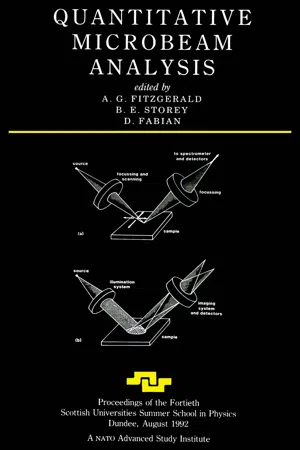
- 350 pages
- English
- ePUB (mobile friendly)
- Available on iOS & Android
Quantitative Microbeam Analysis
About This Book
Quantitative Microbeam Analysis provides a comprehensive introduction to the field of quantitative microbeam analysis (MQA). MQA is a technique used to analyze subatomic quantities of materials blasted from a surface by a laser or particle beam, providing information on the structure and composition of the material. Contributed to by international experts, the book is unique in the breadth of microbeam analytical techniques covered. For each technique, it develops the theoretical background, discusses practical details relating to choice of equipment, and describes the current advances. The book highlights developments relating to Auger electron spectroscopy in scanning electron microscopes and transmission electron microscopes and advances in surface analytical imaging and accelerated ion beam-surface interactions.
Frequently asked questions
Information
Quantification in AES and XPS
Teddington, Middlesex
1 Introduction
1.1 The basic principles of AES and XPS

Table of contents
- Cover
- Half Title
- Title Page
- Copyright Page
- Table of Contents
- Quantification in AES and XPS
- Surface Analytical Imaging
- Electronic Structure and Electron Spectroscopy
- Auger Electron Spectroscopy in the STEM
- Electron Energy-Loss Spectroscopy—EELS
- Light Element Microanalysis and Imaging
- A Comparison of Quantification Methods and Analytical Techniques
- Data Analysis and Processing
- Microscopy and Microanalysis of Insulating Materials
- Electron Specimen Interactions
- Electron Probe X-ray Microanalysis
- Energy Dispersive X-Ray Analysis (EDX) in the TEM/STEM
- Analysis and Imaging by Proton-Induced X-Ray Emission (PIXE)
- Ion-Beam Analytical Techniques—Rutherford Backscattering, Elastic Recoil and Nuclear Reaction Analysis
- Quantitative Analysis of Solids by SIMS and SNMS
- Static SIMS
- Applications of Surface, Interface and Thin Film Analysis in an Industrial Research Laboratory
- Ion-Induced Auger Electron Emission From Solids
- Resonance Ionisation Mass Spectrometry (RIMS)
- Appendix: a list of Acronyms
- Contributed papers by students
- List of Participants
- Index